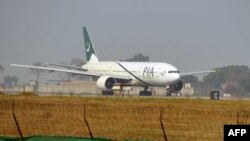ເນື່ອງໃນໂອກາດຄົບຮອບ 20 ປີ ໃນການຖືກໂຈມຕີເມື່ອວັນທີ 11 ກັນ ຍາ ຫລື 9/11 ທີ່ຈະມາເຖິງນີ້, ທ່ານນາງ ຈູລີ ທາໂບ (Lulie Taboh) ນັກຂ່າວຂອງ VOA ຈະພາທ່ານໄປຮູ້ຈັກກັບບາງຢ່າງຂອງເທັກໂນໂລຈີທີ່ປະຕິບັດງານຮັກສາສະໜາມບິນຂອງສະຫະລັດ ໃຫ້ມີຄວາມປອດໄພ ດັ່ງ ທິບສຸດາ ມີລາຍລະອຽດຂອງເລື້ອງນີ້ ມາສະເໜີທ່ານໃນອັນດັບຕໍ່ໄປ.
ທ່ານໂທມາສ ຄາເຕີ (Thomas Carter) ຍັງຈື່ຈໍາເຫດການຄວາມຢ້ານກົວທີ່ທ່ານຮູ້ສຶກໄດ້ໃນເວລາທີ່ແນມເຫັນເຮືອບິນ ມາຕໍາໃສ່ຕຶກແຝດສູນກາງການຄ້າໂລກ ຫລື World Trade Center ຢ່າງແຮງ.
ທ່ານໂທມາສ ຄາເຕີ, ຫົວໜ້າໜ່ວຍຮັກສາຄວາມປອດໄພດ້ານການຂົນສົ່ງຂອງລັດຖະບານກາງ ຫຼື TSA (Transportation Security Administration) ກ່າວວ່າ:
“ເມື່ອໄດ້ເຫັນເຫດການເຫລົ່ານັ້ນເກີດຂຶ້ນຕໍ່ໜ້າຕໍ່ຕາ, ເຈົ້າຮູ້ໂລດວ່າມັນບໍ່ມີຫຍັງທີ່ຈະກັບມາເປັນຄືເກົ່າ.”
ທ່ານຄາເຕີ ປັດຈຸບັນເປັນຜູ້ອຳນວຍການ ຂອງລັດຖະບານກາງ ທີ່ພະແນກຄຸ້ມຄວາມປອດໄພທາງດ້ານການຂົນສົ່ງ, ເຊິ່ງເປັນໜ່ວຍງານຂອງລັດຖະບານກາງທີ່ເບິ່ງແຍງສະໜາມບິນຕ່າງໆໃນທົ່ວປະເທດ. ເຊິ່ງທ່ານຄາເຕີ ກ່າວວ່າ:
“ເທັກໂນໂລຈີເປັນພາກສ່ວນສໍາຄັນ ຂອງພາລະກິດຕໍ່ຕ້ານການກໍ່ການຮ້າຍ, ແລະ ເປັນສິ່ງສໍາຄັນຫລັກຂອງພວກເຮົາ.”
ເທັກໂນໂລຈີນັ້ນ ມັກຈະແນມເບິ່ງບໍ່ເຫັນເວລາຍ່າງຜ່ານຈຸດກວດກາອາດຈະລວມເຖິງເຄື່ອງສະແກນ ທີ່ໃຊ້ຂັ້ນຕອນວິທີໃນການວິເຄາະຊອກຫາເຄື່ອງທີ່ມີຄວາມສົງໄສຢູ່ພາຍໃນກະເປົາ, ຄື້ນແສງເພື່ອກວດກາຂອງແຫລວສໍາລັບວັດຖຸລະເບີດ, ແລະການມາເຖິງ ສະໜາມບິນໃກ້ໆເຈົ້າ ເຄື່ອງກວດລະບົບການສະແດງອອກຂອງຮ່າງກາຍເຊັ່ນວ່າ ເທັກໂນໂລຈີ ໃນການຈົດຈໍາໃບໜ້າ ທີ່ສາມາດຊ່ວຍຢືນຢັນຕົວຕົນຂອງບຸກຄົນນັ້ນໄດ້.
ເຄື່ອງເທັກໂນໂລຈີຮູບພາບຄຸນນະພາບສູງ ຫລື AIT (Advanced Imaging Technology), ເຊິ່ງໄດ້ຮັບການພິຈາລະນາວ່າ ເປັນຄົນງານປະຈໍາຈຸດກວດກາຄວາມປອດໄພ, ໂດຍສະແກນທົ່ວຮ່າງກາຍ ທີ່ໃຊ້ເທັກໂນໂລຈີ ຄື້ນມີລີແມັດຂະ
ໜາດນ້ອຍທີ່ຜ່ານເຂົ້າໄປໃນເສື້ອຜ້າ ເພື່ອຊອກຫາສິ່ງຜິດປົກກະຕິຕ່າງໆເຊັ່ນວ່າ ລະເບີດ ຫລືອຸປະກອນການຜະລິດລະເບີດ.
ເຊິ່ງທ່ານໂທມາສ ຄາເຕີກ່າວຜ່ານການສົນທະນາທາງຊູມວ່າ:
“ຖ້າເຈົ້າເປັນມືລະເບີດສະຫລະຊີບ, ເຈົ້າຈະຕ້ອງເຊື່ອງລະເບີດນັ້ນໄວ້ທີ່ບ່ອນໃດບ່ອນນຶ່ງເທິງໂຕຂອງເຈົ້າ. ເຄື່ອງມືດັ່ງກ່າວນີ້ ຊ່ວຍໃຫ້ພວກເຮົາສາມາດກວດພົບສິ່ງນັ້ນໄດ້.”
ເຄື່ອງເທັກໂນໂລຈີຫລ້າສຸດບາງອັນປະຈໍາສະໜາມບິນ ແມ່ນມາຈາກອຸດສາຫະກໍາທາງການແພດ.
ເຄື່ອງເອັກສະເຣຄອມພິວເຕີນີ້ ເຮັດວຽກຄືກັນກັບການຖ່າຍພາບດ້ວຍຄື້ນເຫລັກກ້າ ຫລືທີ່ຮ້ອງວ່າເຄື່ອງ MRI (Magnetic Resonance Imaging), ເຮັດໃຫ້ຜູ້ທີ່ປະຕິບັດງານການກວດສອບແນມເຫັນເປັນພາບ 3 ມິຕິ ທີ່ສາມາດໝຸນອ້ອມຮອບໄດ້ເຖິງ 360 ອົງສາ.
ເຊິ່ງທ່ານຄາເຕີກ່າວວ່າ:
“ອັນໄດ້ຊ່ວຍໃຫ້ບັນດາເຈົ້າໜ້າທີ່ຂອງພວກເຮົາ ໄດ້ພາບທີ່ແຈ່ມແຈ້ງມີຄວາມ
ໝາຍສູງ, ມີຄຸນນະພາບ ແລະລາຍລະອຽດສູງ.”
ທ່ານເຈຟເຟຣ ໄພສ໌ (Jeffrey Price), ຜູ້ຊ່ຽວຊານດ້ານຄວາມປອດໄພຂອງສາຍການບິນໄດ້ກ່າວຜ່ານການສົນທະນາທາງຊູມວ່າ:
ແມ່ນຫຍັງກໍ່ຕາມ “ພວກເຮົາເຫັນໃນເວລານີ້ແມ່ນເທັກໂນໂລຈີທີ່ດີກວ່າສິ່ງຂອງຫລາຍສິ່ງທີ່ພວກເຮົາເຄີຍໄດ້ປະຕິບັດມາແລ້ວໃນຊ່ວງ 10 ປີທີ່ຜ່ານມາ ຫລືຫລາຍກວ່ານັ້ນ.”
ເມື່ອເບິ່ງໄປໃນອະນາຄົດ, ທ່ານຄາເຕີກ່າວວ່າ ອາດຈະມີມື້ນຶ່ງ ທີ່ບັນດານັກເດີນທາງສະແກນໂຕພວກເຂົາເຈົ້າເອງຢູ່ທີ່ຈຸດກວດກາ, ດ້ວຍການຈໍາກັດໃນການສໍາພັດ ແລະການໃຊ້ລະບົບກວດກາທາງຮ່າງກາຍນັ້ນເປັນຫລັກ. ໂດຍກ່າວວ່າ:
“ນັ້ນລວມເຖິງການຈົດຈໍາໃບໜ້າ, ສະແກນແກ້ວຕາ ຫລືລາຍມື ເປັນຕົ້ນ.”
ທ່ານຄາເຕີກ່າວວ່າ ການລະລຶກຄົບຮອບ 20 ປີຂອງວັນທີ 11 ກັນຍາ ຫລື 9/11, ຈະເປັນວັນແຫ່ງຄວາມຊົງຈໍາ, ແຫ່ງຄວາມນຶກຄິດພິຈາລະນາ ແລະເປົ້າໝາຍໃນການເລີ້ມຕົ້ນໃໝ່. ໂດຍກ່າວຜ່ານທາງຊູມວ່າ:
“ພວກເຮົາຮູ້ວ່າ ນັ້ນມັນເປັນການສະແດງເຖິງຄວາມເຂັ້ມແຂງຂອງປະເທດຂອງພວກເຮົາ, ແລະພວກເຮົາຮູ້ວ່າ ພວກເຮົາມີພາລະໜ້າທີ່ຢູ່ຂ້າງໜ້າຂອງພວກເຮົາເພື່ອທໍາການປົກປັກຮັກສາ.”
ເທັກໂນໂລຈີທີ່ມີຄວາມກ້າວໜ້າສູງ ແລະຄວາມອົດທົນທີ່ເພີ້ມຂຶ້ນ ຂອງຜູ້ໂດຍ ສານທັງຫລາຍໃນທົ່ວໂລກ, ທັງໝົດນີ້ສາມາດຊ່ວຍໃນການປະຕິບັດໜ້າທີ່ເພື່ອເຮັດໃຫ້ການເດີນທາງໂດຍທາງອາກາດນັ້ນ ມີຄວາມປອດໄພຍິ່ງຂຶ້ນ.
As the 20th anniversary of the 9/11 attacks approaches, VOA’s Julie Taboh looks at some of the technology that works to keep U.S. airports safe.
Thomas Carter remembers the horror he felt watching planes crash into the twin towers of the World Trade Center.
((Thomas Carter, TSA Federal Security Director)) ((Courtesy: Zoom))
“To watch those events unfold before my eyes, you knew that nothing would ever be the same.”
Carter is now a federal security director at the Transportation Security Administration, the U.S. federal agency that oversees the nation’s airports. He says the mission to make airports safer has in recent years increasingly turned to technology.
((Thomas Carter, TSA Federal Security Director)) ((Courtesy: Zoom))
“Technology is a key facet of our counterterrorism mission, and it's one of our key tools.”
That technology -- often invisible to the traveler moving through checkpoints -- can include scanners that use algorithms to analyze a suspicious item inside a bag, light waves checking liquids for explosives, and -- coming to an airport near you -- biometrics, such as facial recognition technology that can help confirm a person’s identity.
The AIT, or advanced imaging technology machine, considered the workhorse of checkpoint security,
scans the contours of the body using millimeter wave technology -- radio waves passing through clothing -- looking for anything unusual, such as explosives or bomb-making equipment.
((Thomas Carter, TSA Federal Security Director)) ((Courtesy: Zoom))
“If you were a suicide bomber, you would have to place that device somewhere on your person. This machine allows us to detect that.”
Some of the latest airport security technology comes from the medical industry.
The computed tomography machine works like a magnetic resonance imaging, or MRI machine, giving inspectors a 3-D view that can be rotated 360 degrees.
((Thomas Carter, TSA Federal Security Director))
“Which allows our officers to get an extremely high-definition, high-resolution image.”
((Jeffrey Price is a professor at the Metropolitan State University of Denver, Department of Aviation and Aerospace Science. He spoke to VOA via Zoom))
What "We're seeing now is better technology of things we've already been doing for the past decade or so.”
Looking to the future, Carter says there may come a day when travelers scan themselves into the checkpoint, with limited touching and mainstream use of biometrics.
((Thomas Carter, TSA Federal Security Director)) ((Courtesy: Zoom))
“That includes facial recognition, retina scanning or fingerprints.”
The 20th anniversary of 9/11, Carter says, will be a day of remembrance, reflection and a renewal of purpose, especially as he looks to the Freedom Tower in Manhattan, built where the twin towers once stood.
((Thomas Carter, TSA Federal Security Director)) ((Courtesy: Zoom))
“We know that that represents the strength of our nation, and we know that we have a mission ahead of us to protect it.”
Advanced technology, and extra patience from passengers worldwide, all can help in the mission to help keep air travel safe.





